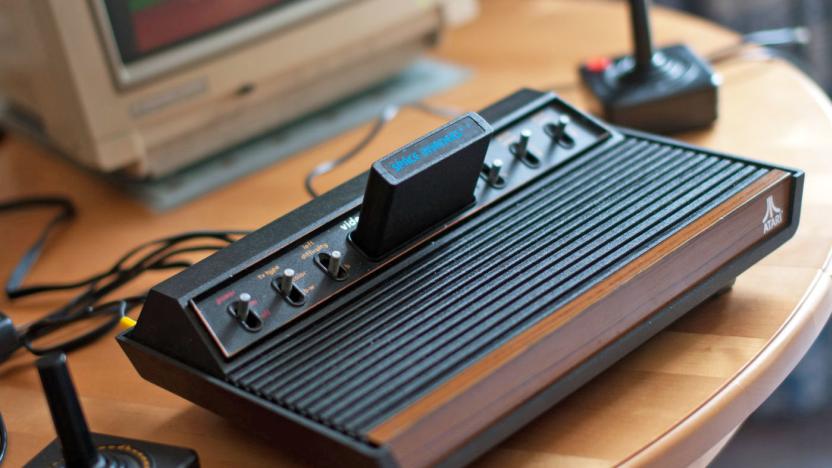IoT
Latest

Whirlpool is putting Innit's smart recipes on its WiFi ovens (updated)
Getting recipes and other cooking tips directly on a connected appliance is increasingly becoming the norm, and Whirlpool is one of the next in line. The company announced that it's Jenn-Air line of WiFi-equipped ovens will soon feature Innit recipes. While Innit aims to tackle the entire kitchen, including food storage and more, personalized recipes work with the connected oven and your tablet or phone. The appliance adjusts cooking to the weight and type of food to help ensure the results are what they should be.

The Internet of Things is coming to your hydroponic garden
It was only a matter of time. The Internet of Things has already come for our vaporizers; now it is back for our hydroponic grow ops. Behold the Gro.io, an all-inclusive hydro system that's nearly fully automated. The brains behind this system is the Gro.hub. This central computing tower runs an embedded Linux OS on a 1GHz ARM Cortex-A8 Processor and processes signals from ten separate remote sensors. These monitor things like water temperature, level, pH and flow.

Apple needed to make a standalone HomeKit app
HomeKit, Apple's platform for the Internet of Things, was introduced in 2014. Last year, hardware makers finally started selling devices with companion apps that supported the architecture. But the one thing missing from that platform was an accompanying app built by Apple. Instead, the company decided to let developers take care of that. Apple set up the framework and third parties were supposed to build a beautiful front end around it. But it didn't quite happen that way.

The NSA wants to spy on the Internet of Things
We already know the National Security Agency is all up in our data, but the agency is reportedly looking into how it can gather even more foreign intelligence information from internet-connected devices ranging from thermostats to pacemakers. Speaking at a military technology conference in Washington D.C. on Friday, NSA deputy director Richard Ledgett said the agency is "looking at it sort of theoretically from a research point of view right now." The Intercept reports Ledgett was quick to point out that there are easier ways to keep track of terrorists and spies than to tap into any medical devices they might have, but did confirm that it was an area of interest.

Target has an in-store space for explaining the smart home
Last year Target unveiled its Internet of Things "Open House" experiment in San Francisco. The goal was to create a shopping experience that would help customers figure out how connected devices work with each other. In the confusing and fragmented world of IoT, the retailer carved out a little corner of knowledge. Now it's moving past the testing phase and opening a "connected living experience" in a suburban Minneapolis store.

Atari returns to hardware with smart home gadgets
Classic video game brand Atari has announced it's making new hardware, but sadly it's not a new console. Instead, it's making connected home and smart devices. There aren't many details about exactly what new gadgets they'll make, but they will range from "simple" to "highly sophisticated," and will be in the home, pets, lifestyle and safety categories. The company also says the new gear is a result of a partnership with Sigfox -- the same company behind the connected Antarctic research base. Sigfox's IoT technology will provide instant the connectivity and the promise of extra long battery life.

Recommended Reading: Is the VR hype train grinding to a halt?
Why the virtual-reality hype is about to come crashing down Christoper Mims, Wall Street Journal While VR seems to be all the rage this year, WSJ's Christopher Mims argues that the bubble is about to burst. Mims says that it'll be the limited content that will ultimately derail the virtual reality hype train, and that it could happen sooner rather than later.

ICYMI: Smart coats, robot whiskers and vaporizing lasers
Today on In Case You Missed It: Google and Levi's team up to make a smart Canadian Tuxedo jacket, the University of Bristol teaches a whiskered robot to react to stimuli and Stanford's Linear Accelerator fries water droplets with an X-ray laser, because science!

Google Home will take on Echo to be your at-home assistant
While the New York Times may have broken the news early, Google's answer to Amazon's smart speakers is now official. Announced today at the search giant's annual I/O developer conference, Google Home is the company's answer to the Amazon Echo, whose voice-controlled "Alexa" assistant can help with various tasks. Google Home has a virtual assistant too, with software that can handle household tasks like adjusting your Nest thermostat. It also allows you to control third-party apps using your voice.

Device that makes surfaces smart reaches funding in an hour
The Knocki team's Kickstarter campaign was a huge success: they managed to raise $35,000 in just over an hour. They've even reached $136,000 as of this writing. What enticed people to put their faith in Knocki's creator (Texas-based Swan Solutions) is the promise of a device that can turn any surface into a controller for various gadgets and smart devices in your home. So long as you attach a Knocki onto, say, a table, a countertop or a wall, it can recognize up to 10 unique tapping and knocking patterns.

NYT: Google's Echo competitor is called 'Home'
Google's answer to the Amazon Echo is named Google Home, according to The New York Times. Google Home, which was developed under the codename "Chirp," is a voice-powered assistant that can answer basic questions as you bustle around the house. The device should hit stores in the fall and Google is set to unveil the device during its big I/O conference tomorrow, NYT reports.

Program Amazon's new Dash button for tasks, not products
I have a trio of Amazon Dash buttons scattered around my house to lend a hand when I run low on flushable wipes, whey protein powder and dish soap. There's really no downside to trying them out, since the online retailer reimburses you for the device after your first purchase. Amazon's latest Dash button isn't for re-ordering products though, it's a programmable option that lends a hand with tasks and controlling your IoT devices.

uHoo edges out other air quality monitors with extra sensors
We've now gotten to the point where we can rely on pigeons for monitoring outdoor air quality, and there are plenty of conventional options for indoor as well. But there's always room for improvement, which is why we're looking at the uHoo. Impressively, this pint glass-sized device packs up to five air pollutant sensors, thus allowing it to measure the usual dust and volatile organic compounds, as well as carbon dioxide, carbon monoxide and ozone -- these three can't be detected by most other monitors in the consumer market. On top of that, the uHoo can also keep an eye on the temperature, humidity and air pressure, which comes in handy as these contribute to our wellness, too. The live data is fed to your iOS or Android device via Wi-Fi, and the app will alert you when the air goes bad in one of the rooms.

Microsoft buys a company enabling the Internet of Things
If it wasn't already evident that Microsoft is serious about becoming a big player in the Internet of Things, it is now. The tech pioneer has bought Solair, a company focused on Internet of Things services for businesses -- say, making sure that factory machines are running smoothly. Microsoft isn't divulging exact plans yet, but it expects to fold Solair's tech into Azure's IoT Suite. You may not witness the fruits of this acquisition first-hand, but don't be surprised if the gadgets you buy arrive sooner and with fewer flaws.

Google's OnHub router uses IFTTT to automate your life
Google's $200 OnHub router arrived last year, delivering fast WiFi in a device that touted an easy setup and automatic security updates. In the months following its arrival, the company has also added features like guest mode and band steering. Today, OnHub became even more useful as Google announced that the device now supports automated recipes from IFTTT. For the uninitiated, IFTTT uses formulas called recipes to automate certain behaviors based on things like a device's location, time of day or some activity.

Triby will be the first non-Amazon device to get Alexa
Amazon set up a $100 million fund last year to help developers integrate Alexa Voice Service (AVS), the tech in the Echo, into their third-party devices. The first of these to hit the market is the Triby, a portable voice-controlled hub built by Invoxia.

Otto is Samsung's cute personal assistant robot
Samsung unveiled a big new push into Internet of Things at its developer conference today, and it's using a cute little robot to demonstrate it. It's called the Otto, a reference design for what is essentially an Amazon Echo clone. It has microphones and speakers so it can answer questions like "What's the weather?," plus you can use it to control various connected gadgets in your home like light switches and refrigerators.

Intel explains its strategy for moving beyond the PC
When Intel slashed thousands of jobs as part of its big attempt to expand beyond the PC, it left a lot of people wondering: just what is this strategy, and why is it so vital? As of today, you have a better (if imperfect) explanation. CEO Brian Krzanich has outlined that strategy in a lengthy editorial. He believes that the cloud is the most important thing forming the "smart, connected world," and that everything revolves around it. That means fostering 5G data access, connecting the internet of things and pushing for technology that improves computing power in devices and data centers, such as ever-denser processors and extra-fast 3D memory.

PillDrill does smart medication tracking in style
Folks who rely on medication for a long period may forget their routine once in a while, especially the elderly or anyone with memory loss. It also gets rather dull when every conversation with the family starts with, "Have you taken your pills yet?" This is where PillDrill comes in. The system consists of a hub that resembles a cute-looking alarm clock, a couple of weekly pill strips containing RFID pods (you can add more strips, too), a dozen alphabetical RFID tags for your own bottles, a "mood cube" and a mobile app. You don't need to learn how to program your schedule: Just take your pills the way you're used to -- be it with the pods on the pill strips or with the original pill bottles -- and scan their RFID tags onto the right hand side of the hub as you go along.

Hackers hijack radio stations to air a furry podcast
In the kind of story we should probably get used to hearing, Ars Technica digs into an incident Tuesday morning where someone redirected multiple radio stations including KIFT and KXAX to broadcast an archived episode of a NSFW podcast for the furry community. It's not clear who was responsible, but it appears to be linked to a coordinated effort to compromise Barix boxes many radio stations use to stream content for broadcasts. As we've seen with security cameras, baby monitors, cars and other connected devices, if something is left exposed to the wider internet with a default or weak password, hackers can and probably will access it.










